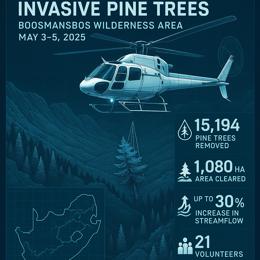Image created by AI
Expanding Knysna's Elephant Population: SANParks Considers Introduction of More Elephants After Rare Sighting
Amidst the dense forests and striking fynbos of the Knysna region, a rare and exciting development has emerged. The South African National Parks (SANParks) recently confirmed a sighting of a wild female elephant – an event stirring significant interest in the conservation community and potentially marking a new chapter for the region's ecological narrative.
This female elephant, an elusive inhabitant of the Knysna forest, may soon not wander alone. SANParks has announced that following comprehensive studies assessing both public sentiment and ecological prerequisites, the introduction of more elephants to the historic Garden Route elephant range is being considered.
The sociological assessments, which addressed community attitudes towards the potential influx of these majestic creatures, displayed an overwhelming response rate of 74% from 500 contacts. The results signified a robust inclination towards reviving the forest's elephant population. Respondents cited multiple justifications for their support, including the reinforcement of ecological balance, cultural enrichment, and the honor of historical legacy, all while emphasizing the importance of avoiding the pitfalls of commercial exploitation.
At the same time, meticulous ecological evaluations were conducted to comprehensively scrutinize the current lone elephant's health, behavior, and interactions with the forest and its human neighbors. These studies painted a portrait of an elephant in good physiological condition, displaying regular behaviors and adapting her movement patterns to minimize human contact.
Particularly noteworthy were the insights gained from the analysis of stress hormones found in the elephant's dung. The stress markers, indicative of her overall well-being, suggested that the forest’s low human population density areas were conducive to her comfort. Yet, it was also clear that human pursuit was a stress factor, as noted in regions of high human activity.
The camera traps deployed within the forest acted as silent witnesses to her comportment. The footage showed a creature at ease in the wilderness, save for encounters with her bipedal counterparts, where her elevated stress levels became evident.
Such meticulous attention to her behavioral responses to human activities served an important purpose. The information collected on potential human-wildlife conflict zones and the conditions leading to the decline and eventual extinction of the original elephant populations provided insights necessary for informed and careful future management.
Taking a cue from both the sociological and ecological findings, SANParks has adopted a management stance that is thoughtful and prudent. Emphasizing a minimal-disturbance approach, future decisions will hinge on the guidance of elephant specialists, as well as input from landowners and conservation authorities.
The rare sighting of this solitary female elephant could herald the return of a population long thought to be a whisper of history. Through dedicated research and community collaboration, SANParks is paving the way for a responsible rewilding initiative that may see the gentle giants of Knysna roaming their ancient stomping grounds once again.










